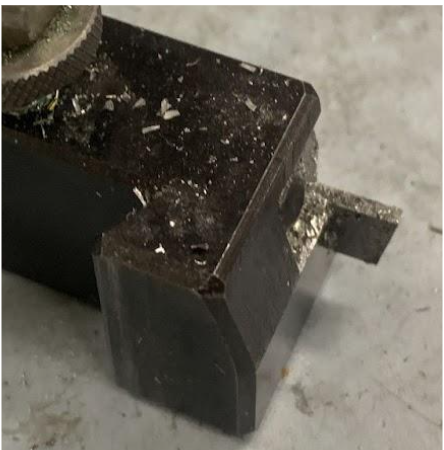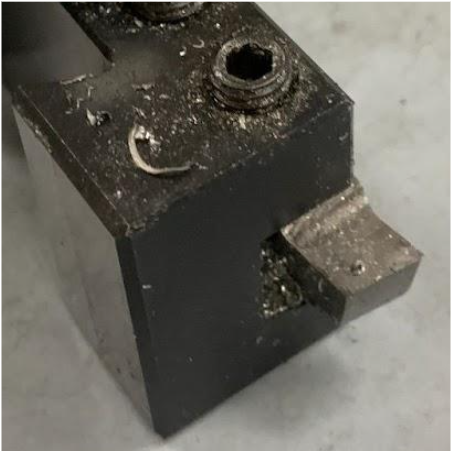Lathe Training
5.0(3)
5.0(3)
Card Sorting
1/26
Earn XP
Description and Tags
Study Analytics
Name | Mastery | Learn | Test | Matching | Spaced |
|---|
No study sessions yet.
27 Terms
1
New cards
Shop Safety Rules
1.) Safety Glasses
2.) Closed toed shoes
3.) Tied up hair
4.) Pants that cover your knees
5.) Roll up your sleeves
6.) Cover shoulders, midriff, and back
7.) No dangling stings or jewelry
8.) No headphone or AirPods in ears
2.) Closed toed shoes
3.) Tied up hair
4.) Pants that cover your knees
5.) Roll up your sleeves
6.) Cover shoulders, midriff, and back
7.) No dangling stings or jewelry
8.) No headphone or AirPods in ears
2
New cards
Uses of the Lathe
1.) Turning
2.) Facing
3.) Parting
4.) Drilling
5.) Slotting
6.) Tapping
2.) Facing
3.) Parting
4.) Drilling
5.) Slotting
6.) Tapping
3
New cards
Stock for the Lathe
1.) Cylindrical Rod
2.) Hexagonal Rod
3.) Square Rod (Square stock is never used on Lathe, but the video mentioned it)
2.) Hexagonal Rod
3.) Square Rod (Square stock is never used on Lathe, but the video mentioned it)
4
New cards
Dimensions of Stock
1.) Length
2.) Diameter
3.) End Face == circular face of stock
2.) Diameter
3.) End Face == circular face of stock
5
New cards
Types of Lathes
1.) Collet Lathe(Garfunkel), Collet Lathe holds on to stock with a collet of a fixed diameter
2.) Chuck Lathe(Simon), Chuck Lathe holds on to stock with its jaws to clamp it in place
2.) Chuck Lathe(Simon), Chuck Lathe holds on to stock with its jaws to clamp it in place
6
New cards
Emergency Stops
1.) Do Not use Emergency Stops unless you are in an emergency!
2.) If You Use emergency stops, alert a supervisor before turning in back on!
2.) If You Use emergency stops, alert a supervisor before turning in back on!
7
New cards
Handling Lathe Tools
1.) Tools are sharp
2.) Take your time, and make sure you are safe
3.) Use a brush not your hand to clean tools
2.) Take your time, and make sure you are safe
3.) Use a brush not your hand to clean tools
8
New cards
Chuck Lathe: Inserting Stock
1.) Put stock into the three jaws
2.) Tighten jaws using Chuck Key
3.) Once the stock is tight enough, REMEMBER TO REMOVE CHUCK KEY
4.) Pull on stock to make sure it is securely in the jaws
5.) REMEMBER: (⅓ or 6") or less of the stock should be sticking out of the jaws
2.) Tighten jaws using Chuck Key
3.) Once the stock is tight enough, REMEMBER TO REMOVE CHUCK KEY
4.) Pull on stock to make sure it is securely in the jaws
5.) REMEMBER: (⅓ or 6") or less of the stock should be sticking out of the jaws
9
New cards
Collet Lathe: Inserting Stock
1.) Choose collet
2.) Insert collet inside spindle to match alignment with the pin
3.) Turn knob clockwise to tighten stock
4.) Push tightening lever back and stop when correct tightness is found
5.) Push lock down and rotate slightly for a click
6.) REMEMBER: (½ or 6") or less of the stock should be sticking out of the collet
2.) Insert collet inside spindle to match alignment with the pin
3.) Turn knob clockwise to tighten stock
4.) Push tightening lever back and stop when correct tightness is found
5.) Push lock down and rotate slightly for a click
6.) REMEMBER: (½ or 6") or less of the stock should be sticking out of the collet
10
New cards
Lathe Operations
1.) Parting reduces the length of the stock
2.) Facing creates a smooth and even face at the end of the stock by shaving of a little bit of the end face
3.) Drilling is the process of creating a hole in the stock, remember to add 0.25 inches to the end of the hole due to the conical shape of the drill bit
4.) Tapping is the process of creating threads in a drilled hole
5.) Turning is the process of reducing the diameter of the stock
6.) Slotting is the process of creating a reduced diameter in the middle of the stock
2.) Facing creates a smooth and even face at the end of the stock by shaving of a little bit of the end face
3.) Drilling is the process of creating a hole in the stock, remember to add 0.25 inches to the end of the hole due to the conical shape of the drill bit
4.) Tapping is the process of creating threads in a drilled hole
5.) Turning is the process of reducing the diameter of the stock
6.) Slotting is the process of creating a reduced diameter in the middle of the stock
11
New cards
Location of Stored Stock
1.) The Bin
2.) Cat Closet
2.) Cat Closet
12
New cards
How to zero the Axis
1.) Use the X-axis knob to face
2.) Gently touch the face and press zero
3.) Move the tool back in the x direction
4.) Manually turn chuck/spindle
5.) Repeat until zeros are
2.) Gently touch the face and press zero
3.) Move the tool back in the x direction
4.) Manually turn chuck/spindle
5.) Repeat until zeros are
13
New cards
Steps for Parting
1.) Position parting tool using X-axis crank
2.) Oil and engage motor level
3.) Move parting tool halfway into stock
4.) Move away and disengage the motor control lever
2.) Oil and engage motor level
3.) Move parting tool halfway into stock
4.) Move away and disengage the motor control lever
14
New cards
Steps for Turning
1.) Move y to desired distance
2.) Oil
3.) Turn on motor level
4.) Use x axis to move into the stock
5.) Move tool away once done
6.) Turn off motor level
2.) Oil
3.) Turn on motor level
4.) Use x axis to move into the stock
5.) Move tool away once done
6.) Turn off motor level
15
New cards
Steps for Facing
1.) Move tool into needed x position for DRO
2.) Oil
3.) Engage motor control level
4.) Use y axis to move into stock halfway
5.) Move away and turn off motor control level
2.) Oil
3.) Engage motor control level
4.) Use y axis to move into stock halfway
5.) Move away and turn off motor control level
16
New cards
Steps for Tapping
1.) Set up tap guide, tap handle and tap
2.) Keep moving the tailstock into the part until there is resistance
3.) Oil tap
4.) Rotate ½ CW, ¼ CCW. Change speeds and adjust tailstock if needed.
5.) Once finished, move the tailstock back and rotate the tap out of the part.
2.) Keep moving the tailstock into the part until there is resistance
3.) Oil tap
4.) Rotate ½ CW, ¼ CCW. Change speeds and adjust tailstock if needed.
5.) Once finished, move the tailstock back and rotate the tap out of the part.
17
New cards
Steps for Slotting
1.) Move tool to needed x position
2.) Oil
3.) Engage motor control lever
4.) Move slotting tool into part using y axis knob
5.) Move slotting tool away from part using y axis knob once you are satisfied
6.) Disengage motor control lever
2.) Oil
3.) Engage motor control lever
4.) Move slotting tool into part using y axis knob
5.) Move slotting tool away from part using y axis knob once you are satisfied
6.) Disengage motor control lever
18
New cards
Chuck Lathe: Change Speeds
1.) Reference chart for correct speed of aluminum + steel
2.) Turn knobs one at a time while manually turning the chuck
3.) Make sure there is a click or change in resistance
2.) Turn knobs one at a time while manually turning the chuck
3.) Make sure there is a click or change in resistance
19
New cards
Collet Lathe: Change Speeds
1.) Reference chart for correct speed
2.) Change the letter knob while rotating the spindle manually
3.) Make sure there is a click or change in resistance
4.) Change the number knob while rotating the spindle manually
5.) Make sure there is a click or change in resistance
2.) Change the letter knob while rotating the spindle manually
3.) Make sure there is a click or change in resistance
4.) Change the number knob while rotating the spindle manually
5.) Make sure there is a click or change in resistance
20
New cards
How to find Drill Bits and Taps
1.) Go to chart by drill bits
2.) Select the drill bit size right below the tap size
2.) Select the drill bit size right below the tap size
21
New cards
When to Clean the Lathe Bed
1.) When it is full
2.) When we machine plastic or steel
2.) When we machine plastic or steel
22
New cards
Speeds for Materials on the Collet Lathe
1.) Plastics: 1000 rpm
2.) Aluminum: 730 rpm
3.) Steel: 430 rpm
2.) Aluminum: 730 rpm
3.) Steel: 430 rpm
23
New cards
Pass for Facing
0.05 inches
24
New cards
Pass for Parting
0.2 inches
25
New cards
Slotting Tool

26
New cards
Parting Tool

27
New cards
Turning/Facing Tool
